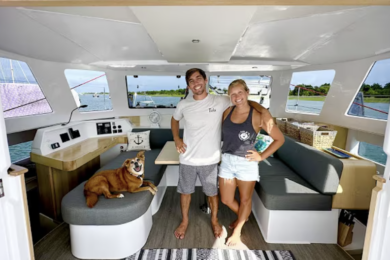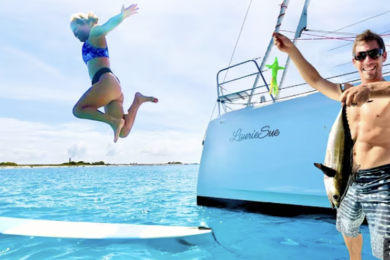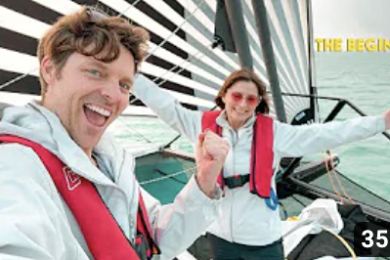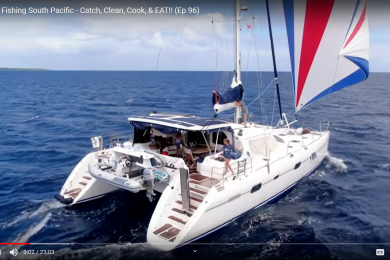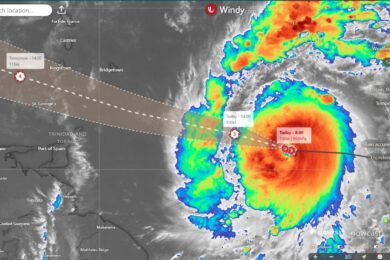A few things to consider before signing on the dotted line (Published Winter 2016)
I help run an American Sailing Association affiliate sailing school in the Caribbean. My partner Chris Rundlett and I operate LTD Sailing—“Living the Dream!” We have found that we receive more requests for catamaran courses, both basic and advanced, than any of the other courses we offer. Out of every 10 inquiries, nine will be for catamaran classes. It’s a trend that is reflected in the type of boats available for charter, as well. You can go to the websites for any of the major players in the charter business and find far more catamarans listed than monohulls (in most markets.) Walk down the Sunsail dock in Tortola, BVI and you will pass rows upon rows of catamarans before you ever see a monohull.
Why?
Catamarans are growing in popularity for many reasons. Two of the main reasons are that they are so stable and the amount of room they offer. The stability appeals to the non-sailors who are uncomfortable, when on a monohull, heeled over, and seeing water splash against the galley window. Great fun for the experienced sailor, but possibly the last sailing trip for your non-sailing friends and family. Catamarans are a great compromise for the reluctant sailor. So, if you have to choose between sailing a catamaran and not sailing at all, well, the choice is obvious. Let’s go sailing!
Learning to sail a cat
Why should you take a catamaran sailing class from a sailing school and not Captain Ron, a friend or family member? Remember when your Dad taught you to drive? How did that go? Hiring a professional allows you to have certain expectations as well as a degree of separation from the emotional connection with someone you care about. Taking a class from a certified sailing school puts you more in control of your goals. Sailing schools focus on education and deliver instruction in a professional, systematic manner to facilitate learning. The instructors are certified to meet certain qualifications and have a demonstrated ability in sailing as well as teaching skills. Some sailing school associations also require instructors to have a professional license such as a United States Coast Guard Captains license or a Royal Yachting Association Yacht master certification. Professional instructors are expected to adhere to a code of ethics, are monitored for quality and are held accountable by their certifying association.
Certifications
More and more countries require certification to sail in their waters. This is largely due to careless or inexperienced sailors who are harming the environment and causing damage to their reefs. Not to mention, what they may do to other boats. Boats can be fixed but the damage done to the reef is forever. This is also a big reason why you will see more mooring fields in places you used to anchor. The mooring balls cause less damage than a dragging anchor and, of course, produce a source income for the local community. Popular cruising destinations like the Mediterranean and recently Belize want to see a certification from a reputable source such as the American Sailing Association (ASA) or Royal Yachting Association (RYA). It is encouraging that governments recognize the need to protect the beauty of their waters.
Destination Sailing Schools
Catamaran Cruise and Learn vacations are often offered in exotic sailing destinations. It’s easy to make your sailing course into an amazing leaning vacation. You can go from basic sailing, to coastal cruising and all the way to catamaran certification in a week to 10 days. Join a group or book a private class with just you and your family. If you are planning to join a group, be sure to ask how many students will be on the boat. You want to be actively involved in sailing, not watching others have all the fun. Once you earn your certification, you can gain confidence and hone your skills by chartering a boat on your own. If you aren’t quite ready to go it alone, joining a flotilla is a great way to gain experience in a helpful environment. Some schools teach on the same catamarans you can charter on your own after the class. When shopping for a sailing school, ask what boats they will be using and if they are available for charter.
Catamaran sailing will open up a whole new world to explore. Having the skills to handle a catamaran confidently and safely will make you a better sailor. There are important differences to sailing a catamaran versus a monohull. Catamarans are often more comfortable and appeal to a wide audience. With more living room, stability under way and comfort at anchor your friends and family may come to love sailing as much as you do!
Chrystal Young lives in Grenada full time. In 2013, she sold her house, quit her job and moved to the Caribbean to start LTD Sailing—“Living the Dream!” with her partner Chris Rundlett. She is also an associate yacht broker for The Multihull Company and 5 Oceans Marine Group. Chrystal is happy to help you with any questions you might have on sailing or vacationing in the Southern Caribbean. Chrystal@LTDsailing.com. Look for her at the Annapolis and Miami Boat Shows.
What’s Covered during a Cruising Catamaran class:
Parts of the cat
Advantages & disadvantages
Weight distribution
Performance
Accommodations
Systems
Draft
Windage
Maneuvering
Dagger boards
Safety
Weather & procedures
Limitations
Auxiliary power
Engines
Docking
Resources:
ASA 114 Textbook – Cruising Catamarans Made Easy

